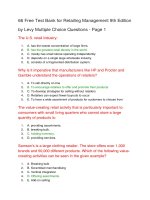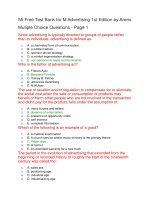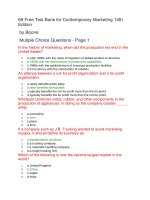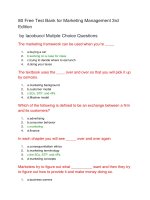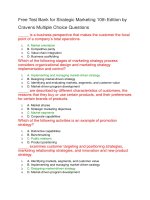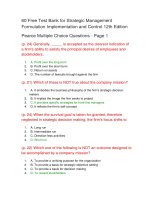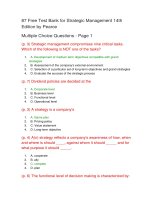87 free test bank for strategic management 14th edition by pearce
Bạn đang xem bản rút gọn của tài liệu. Xem và tải ngay bản đầy đủ của tài liệu tại đây (45.19 KB, 15 trang )
87 Free Test Bank for Strategic Management 14th
Edition by Pearce
Multiple Choice Questions - Page 1
(p. 3) Strategic management compromises nine critical tasks.
Which of the following is NOT one of the tasks?
1.
A. Development of medium-term objectives compatible with grand
strategies
2. B. Assessment of the company's external environment
3. C. Selection of a particular set of long-term objectives and grand strategies
4. D. Evaluate the success of the strategic process
(p. 7) Dividend policies are decided at the
1.
2.
3.
4.
A. Corporate level
B. Business level
C. Functional level
D. Operational level
(p. 3) A strategy is a company's
1.
2.
3.
4.
A. Game plan
B. Pricing policy
C. Value statement
D. Long-term objective
(p. 4) A(n) strategy reflects a company's awareness of how, when
and where is should ____, against whom it should _____ and for
what purpose it should _____.
1.
2.
3.
4.
A. cooperate
B. ally
C. compete
D. plan
(p. 6) The functional level of decision making is characterized by:
1.
2.
3.
4.
A. The board of directors deriving corporate goals
B. Managers of product, geographic and functional areas
C. The CEO developing a company profile
D. Business managers interpreting the mission into operational objectives
(p. 5) Which of the following applies to strategic issues?
1.
2.
3.
A. Consider only the firm's external environment
B. Are future oriented
C. Concern allocation of insignificant amounts of company resources
4.
D. Do not have long-term impact on the firm's prosperity
(p. 6) A business, which by definition is a profit center that focuses
on a specific combination of products, markets, and technologies,
is also known as a
1.
2.
3.
4.
A. Subsidiary
B. Sister unit
C. Strategic business unit
D. Corporate unit
(p. 4) A(n) _____ provides a framework for managerial decisions.
1.
2.
3.
4.
A. Vision
B. Organizational structure
C. Strategy
D. Long-term objective
(p. 5) Strategic decisions are based on what managers _____,
rather than on what they _____.
1.
2.
3.
4.
A. Forecast; know
B. React to; anticipate
C. Know; forecast
D. Compromise with; analyze
(p. 6) Which of these managers tries to identify and secure the
most profitable and promising market segment?
1.
2.
3.
4.
A. Functional managers
B. Corporate managers
C. Business managers
D. Operative
(p. 5) In the middle of the decision-making hierarchy is the _____
level.
1.
2.
3.
4.
A. Corporate
B. Functional
C. Business
D. Strategic
(p. 3) Strategic management involves the _____, directing, _____
and controlling of a company's strategy-related decisions and
actions.
1.
2.
3.
4.
A. Financing; marketing
B. Planning; financing
C. Marketing; planning
D. Planning; organizing
(p. 5) Which level of strategy uses a portfolio approach?
1.
2.
3.
4.
A. Business
B. Operational
C. Corporate
D. Functional
(p. 3) The _______ comprises economic and social conditions,
political priorities and technological developments, all of which
must be anticipated, monitored, assessed and incorporated into
the executive's decision making.
1.
2.
3.
4.
A. Remote external environment
B. Task environment
C. Operating environment
D. Internal environment
(p. 5) Strategic decisions ostensibly commit the firm for
1.
2.
3.
4.
A. 1-2 years
B. The short term
C. 3-4 years
D. A long time, typically five years
(p. 5) Typically how many strategic decision levels are there in the
corporate decision-making hierarchy of a large corporation?
1.
2.
3.
4.
A. 5 or more
B. 4
C. 3
D. 2
(p. 6) Which level of strategy is at the bottom of the decisionmaking hierarchy?
1.
2.
3.
4.
A. Corporate
B. Business
C. Functional
D. Operational
(p. 3) A _____is a company's game plan.
1.
2.
3.
4.
A. Strategy
B. Pricing policy
C. Value statement
D. Long-term objective
(p. 3) Which of the following is NOT a part of a firm's immediate
external environment?
1.
A. Technological development
2.
3.
4.
B. Competitors
C. Suppliers
D. Government agencies
(p. 4) Strategic issues require which level of management
decisions?
1.
2.
3.
4.
A. Operative
B. Top
C. Front-line
D. Middle
(p. 7) Which level of decisions encompasses greater risk, cost
and profit potential?
1.
2.
3.
4.
A. Business
B. Lower echelon
C. Corporate
D. Functional
(p. 7) Decisions concerning plant location, distribution channels,
geographic coverage and market segmentation are typically
made at:
1.
2.
3.
4.
A. The corporate level
B. The business level
C. The functional level
D. The Board level
(p. 4) Strategic issues require large amounts of the company’s
1.
2.
3.
4.
A. strengths
B. opportunities
C. suppliers
D. resources
(p. 7) Decisions at which level of management tend to be more
value-oriented, more conceptual, and less concrete?
1.
2.
3.
4.
A. Functional
B. Corporate
C. Operative
D. Business
(p. 4-5) Some business decisions are strategic and therefore
deserve strategic management attention. Which of the following is
one of the six strategic issue dimensions?
1.
A. Requires front-line employee decisions
2.
B. Is not likely to have a significant impact on long-term prosperity of the
firm
3. C. Necessitates considering factors in the firm's external environment
4. D. Is spontaneous
(p. 3) Which of the following is an element of a firm's remote
external environment?
1.
2.
3.
4.
A. Competition
B. Suppliers
C. Government agencies
D. Economic and social conditions
(p. 5) In a multi-business firm, ______ -level executives determine
the businesses in which the firm should be involved.
1.
2.
3.
4.
A. Business
B. Functional
C. Corporate
D. Operative
(p.3) Large-scale, future-oriented plans, for interacting with the
competitive environment to achieve company objectives refers to
its
1.
2.
3.
4.
A. Strategy
B. Goals
C. Competitive analysis
D. Dynamic policies
(p. 5) Strategic issues are ____ oriented.
1.
2.
3.
4.
A. future
B. present
C. past
D. timelessly
(p. 6) At Office Supply, Inc., ____ -level managers would be
responsible for determining whether the company should be
involved in home furnishings or electronic appliance businesses,
whereas ____ -level managers would be responsible for
determining how the firm will compete in the selected productmarket arena.
1.
2.
3.
4.
A. Business; corporate
B. Corporate; functional
C. Functional; business
D. Corporate; business
(p. 3) The set of decisions and actions that result in the
formulation and implementation of plans designed to achieve a
company's objectives is defined as:
1.
2.
3.
4.
A. Strategic policy
B. Business policy
C. Strategic management
D. Tactics
(p. 7) Corporate-level decisions are characterized by:
1.
2.
3.
4.
A. Decreased risk
B. Doing things right
C. Short-time horizons
D. Greater cost
(p. 6) Which strategic level is typically responsible for developing
annual objectives and short-term strategies?
1.
2.
3.
4.
A. Functional level
B. Corporate level
C. Business level
D. Board of Directors level
(p. 6) Which level of strategy is in the middle of the decisionmaking hierarchy?
1.
2.
3.
4.
A. Corporate
B. Functional
C. Business
D. Strategic
(p. 5) All businesses exist in a(n) _____ system.
1.
2.
3.
4.
A. open
B. closed
C. insular
D. protected
(p. 5) The Walt Disney Company is a multibusiness company. It
typically would have ____ levels of strategy.
1.
2.
3.
4.
A. 5 or more
B. 4
C. 3
D. 2
(p. 6) Functional managers are typically responsible for which of
the following?
1.
A. Annual objectives
2.
3.
4.
B. Tactics
C. Corporate goals
D. Mission
(p. 3) The immediate external environment includes:
1.
2.
3.
4.
A. Competitors
B. S. B. U. s
C. Divisions
D. Management
(p. 5) Strategic decisions have ______ effects on firms.
1.
2.
3.
4.
A. Temporary
B. Short-lived
C. Enduring
D. Limited
(p. 5) The top of the decision-making hierarchy comprises all of
these EXCEPT
1.
2.
3.
4.
A. Board of directors
B. Front-line managers
C. The CEO
D. Administrative officers
(p. 5) To a large extent, attitudes at the corporate level reflect the
concerns of
1.
2.
3.
4.
A. Stockholders and society at large
B. Top managers
C. The CEO
D. The federal government
(p. 6) Who determines the basis on which a company can
compete in the selected product-market arena?
1.
2.
3.
4.
A. Functional-level strategic managers
B. Corporate-level strategic managers
C. Business-level strategic managers
D. Operational managers supervising operative
(p. 6) Which of the following is NOT a level in the decision-making
hierarchy of a firm?
1.
2.
3.
4.
A. Business
B. Corporate
C. Operative
D. Functional
(p. 7) Whereas corporate and business-level managers center
their attention on _____, managers at functional-level center their
attention on ____.
1.
2.
3.
4.
A. Operational issues; strategic issues
B. Doing things right; doing the right things
C. Entrepreneurial mode; adaptive mode
D. Doing the right things; doing things right
87 Free Test Bank for Strategic Management 14th
Edition by Pearce Multiple Choice Questions - Page 2
(p. 13) Which of the following is a generic strategy option?
1.
2.
3.
4.
A. Vertical integration
B. Diversification
C. Differentiation
D. Retrenchment
(p. 10) The behavioral consequences of strategic management
are similar to those of
1.
2.
3.
A. authoritative decision making B. centralized decision making
C. autocratic decision making
D. participative decision making
(p. 13) The results that an organization seeks over a multiyear
period are its
1.
2.
3.
4.
A. Generic strategies
B. Grand strategies
C. Mission statements
D. Long-term objectives
(p. 9) The informal, intuitive and limited approach to strategic
management associated with owner-managers of smaller firm
refers to the ____ mode of formality.
1.
2.
3.
4.
A. Entrepreneurial
B. Functional
C. Planning
D. Adaptive
(p. 12) Which of the following is a major function of the strategic
management model?
1.
2.
3.
A. It helps make profits for the firm
B. It helps in identifying key issues faced by the firm
C. It helps in deciding which products to sell
4.
D. It depicts the sequence and relationships of the major components of the
strategic management process
(p. 10) Managers at the _____ level typically have principal
responsibilities for developing environmental analysis and
forecasting, establishing business objectives and developing
business plans prepared by staff groups.
1.
2.
3.
4.
A. Corporate
B. Functional
C. Operational
D. Business
(p. 13) Horizontal integration is an example of a
1.
2.
3.
4.
A. Generic strategy
B. Grand strategy
C. Functional level strategy
D. SBU strategy
(p. 13) The general plan of major actions through which a firm
intends to achieve is long-term objectives is called its:
1.
2.
3.
4.
A. Generic strategy
B. Long-term goal
C. Grand strategy
D. Mission
(p. 13) Which of the following is an example of a grand strategy?
1.
2.
3.
4.
A. Decentralization
B. Policy making
C. Conglomerate integration
D. Horizontal integration
(p. 12) Social responsibility is a critical consideration for a
company's strategic decision makers since
1.
2.
A. Stockholders demand it
B. The mission statement must express how the company intends to
contribute to the societies that sustain it
3. C. It increases a company's profits
4. D. It helps make decisions
(p. 16) One implication of viewing strategic management as a
process is that strategy formulation and implementation are:
1.
2.
3.
4.
A. Sequential
B. Simultaneous
C. Random
D. Reversible
(p. 16) Influential individuals and groups that are vitally interested
in the actions of the business are called
1.
2.
3.
4.
A. Stockholders
B. Stakeholders
C. Strategists
D. Customers
(p. 12) Description of the company's product, market and
technological areas of emphasis is contained in the
1.
2.
3.
4.
A. Assessment of the external environment
B. Company profile
C. Company mission
D. Interactive opportunity analysis
(p. 14) Broad, precedent-setting decisions that guide or substitute
for repetitive or time-sensitive managerial decision making are
called
1.
2.
3.
4.
A. Goals
B. Strategies
C. Objectives
D. Policies
(p. 9) Which one of these forces DOES NOT determine how much
formality is needed in strategic management?
1.
2.
3.
4.
A. Size
B. Country of origin
C. Complexity of environment
D. Production process
(p. 13) The doubling of EPS within 5 years with increases in each
intervening year is called a(n):
1.
2.
3.
A. Mission
B. Long-term objective
C. Action plan D. Short-term objective
(p. 18) The strategy management process is:
1.
2.
3.
4.
A. Stationary
B. Dynamic
C. Static
D. Radical
(p. 12) Which one of the following is NOT an interactive segment
of a firm's external environment?
1.
2.
3.
4.
A. Functional
B. Remote
C. Industry
D. Operating
(p. 17) Strategic management processes need which of the
following to enhance future decision making?
1.
2.
3.
4.
A. Testing
B. Feedback
C. Discontinuity
D. Projecting
(p. 9) The adaptive mode refers to
1.
A. Strategic formality associated with the large firms that operate under a
comprehensive, formal planning system
2. B. Strategic formality associated with medium-sized firms that emphasize
the incremental modification of existing competitive approaches
3. C. Strategic formality associated with global firms that emphasize cultural
value systems
4. D. Informal, intuitive and limited approach to strategic management with
owner-manager of smaller firms
(p. 15) _____ is concerned with tracking a strategy as it is being
implemented, detecting problems or changes in its underlying
premises and making necessary adjustments.
1.
2.
3.
4.
A. Restructuring strategy
B. Strategic control
C. Internal analysis
D. Functional tactics
(p. 15) _____ is a critical stage in strategy implementation
wherein managers attempt to recast their organization.
1.
2.
3.
4.
A. Continuous improvement
B. Restructuring
C. Strategic control
D. Strategy formulation
(p. 9) There are ____ commonly identified modes based upon
formality in strategic management.
1.
2.
3.
4.
A. 4
B. 2
C. 5
D. 3
(p. 9) The planning mode refers to the
1.
A. Strategic formality associated with the large firms that operate under a
comprehensive, formal planning system
2. B. Strategic formality associated with medium-sized firms that emphasize
the incremental modification of existing competitive approaches
3. C. Strategic formality associated with global firms that emphasize cultural
value systems
4. D. Informal, intuitive and limited approach to strategic management with
owner-manager of smaller firms
(p. 14) The minimum equity position required for all new
McDonald's franchises is an example of:
1.
2.
3.
4.
A. A goal
B. A procedure
C. A policy
D. An objective
(p. 9) The ideal strategic management team includes decision
makers from
1.
2.
3.
A. All three company levels (corporate, business and functional)
B. Just the functional level since they are closest to the customers
C. Just the corporate and business levels given that they focus on doing the
right thing
4. D. Just the top management since they understand the big picture
(p. 9) Which of these is NOT a mode of formality?
1.
2.
3.
4.
A. Adaptive
B. Planning
C. Functional
D. Entrepreneurial
(p. 9) Firms that are basically under the control of a single
individual and produce a limited number of products/services are
referred to as following ______ mode.
1.
2.
3.
4.
A. Entrepreneurial
B. Planning
C. Adaptive
D. Corporate
(p. 12) The external environment consists of:
1.
2.
3.
4.
A. The operating environment
B. Managers
C. Employees
D. Owners
(p. 7) The degree to which participation, responsibility, authority
and discretion in decision-making are specified in strategic
management is called:
1.
2.
3.
4.
A. Informality
B. Formality
C. Functional tactic
D. Dynamic mode
(p. 13) Specific actions that need to be undertaken to achieve
short-term objectives, usually by functional areas, refers to
1.
2.
3.
4.
A. Policies
B. Formality
C. Functional tactics
D. Process
(p. 9) The mode associated with medium-sized firms in relatively
stable environments is called the _____ mode.
1.
2.
3.
4.
A. entrepreneurial
B. adaptive
C. business
D. planning
(p. 13) Which of these refers to short-term, narrow scoped plans
that detail "means" or activities that a company will use to achieve
short-term projects?
1.
2.
3.
4.
A. Policies
B. Formality
C. Vision
D. Functional tactics
(p. 10) Which of these is NOT true about the behavioral effect of
strategic management?
1.
A. Strategy formulation activities enhance the firm's ability to prevent
problems
2. B. Resistance to change is reduced
3. C. Gaps and overlaps in activities among individuals and groups are
increased to ensure the checks and balance
4. D. The employee involvement is strategy formulation improves their
understanding of the productivity reward relationship in every strategy plan
(p. 13) Grand strategies include:
1.
2.
3.
A. Market turnaround
B. Vertical diversification
C. Conglomerate integration
4.
D. Innovation
(p.13) The difference between long-term and short-term
objectives is principally:
1.
2.
3.
4.
A. Greater attainability
B. Greater flexibility
C. Greater measurability
D. Greater specificity
(p. 9) When the CEO is very autocratic, the effectiveness of the
firm's strategic planning and management processes is likely to:
1.
2.
3.
4.
A. Enhance strategic planning but diminish its processes
B. Be greatly enhanced
C. Have no effect
D. Be diminished
(p. 12) Long-term objectives are principally attained through:
1.
2.
3.
4.
A. Annual goals
B. Functional strategies
C. Short-term goals
D. Grand strategy
(p. 9) Very large firms typically use the _____ mode of strategic
management.
1.
2.
3.
4.
A. Adaptive
B. Entrepreneurial
C. Informal
D. Planning
(p. 12) Assessment of the strengths and weaknesses of the
company’s management and organizational structure is a part of
1.
2.
3.
4.
A. Internal analysis
B. Mission statement
C. External environment analysis
D. Corporate goals
(p. 15) Which of these is a form of strategic control in which
managers are encouraged to be proactive in improving all
operations of the firm?
1.
2.
3.
4.
A. Continuous improvement
B. Adaptive mode
C. Functional tactics
D. Planning mode
(p. 9) Which of these is usually positively correlated with the cost,
comprehensiveness, accuracy and success of planning?
1.
2.
3.
4.
A. Greater formality
B. Functional structure
C. Organizational matrix
D. Functional tactics
(p. 15) A flow of information through interrelated stages of
analysis toward achievement of an aim is:
1.
2.
3.
4.
A. A process
B. A procedure
C. A policy
D. A system
